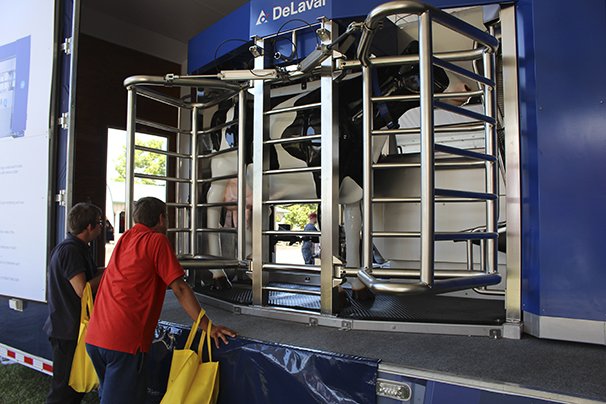
Artificial intelligence (AI) offers nearly every manufacturing and production industry in the U.S. the potential to increase productivity. A major segment of the economy that is behind in utilizing AI and big data to its advantage, however, is our food supply — from the farm to the grocery.
A key part of the problem is that rural America lacks adequate Internet service. In the hinterlands, we’re limited to receiving and sending low numbers of megabytes of data. I recently came to a crossroads with my own Internet service. My staff computer techy guy measured my office Internet connectivity at 0.6 megabytes per second. Yet, six miles east of my home, in Urbana, every Tom, Dick and Harry who wants it can get 200 to 300 megabytes per second service, to watch movies or the gadflies who opine on TV!
“The Internet of Things (IOT)” describes the ability to connect devices, through high-speed internet, to sense, collect, share and process data to fulfill necessary tasks — like milking cows, robotically. An early endeavor in automating milking, in 2005, was a robot that could milk cows several times a day. For this system to work, though, cows had to be taught to step into an electronically mechanized stall whenever they felt the need to let down milk from their alveoli cells into their teats. When an electronic eye detected a cow stepping into a stall, she was rewarded tasty feed. Training her is relatively easy when she knows that tasty feed is her reward. While she munched on her winnings, a robotic arm reached under her udder and cleaned each teat with a spray of water and a tiny amount of diluted, disinfecting iodine. Then the robotic arm attached a teat cup to each teat while activating the vacuum in each cup. By 2008, these systems became widely available.
This process stimulated the cow to release milk into her teats, where it could be removed by the teat cups. The vacuum pulsations of the teat cups pulled the milk to a bulk milk cooling tank by way of a stainless-steel pipe. When a sensor detected that a cow had a fever or was secreting abnormal milk, the system diverted her milk to a separate reservoir for disposal.
This may sound impressive, but all is not well with these systems. In a factory environment, automated systems perform predictably. But this is not necessarily the case when you bring a living creature, like a dairy cow, into the equation.
In this case, all sorts of things can throw off the effectiveness of an automated system like a robotic milker. For instance, a cow could have mastitis, carry a fever, be lame or reluctant to walk into a robotic stall, or have a digestive upset or a severe uterine infection that negatively impacts her milk production. And without warning, she could rambunctiously kick the robotic arm.
Some cows are unlikely to adapt to these systems. (Just like some humans rebel against new technology — or are severely intimidated by it.) Robotic milking systems have not yet been perfected to perform as consistently as farm staff who have been properly trained to milk and care for cows.
The best performing robotic milking system on the market is one made by a Dutch company. This system is considered the preeminent leader in robotic milking. Many of these robotic systems are being used in the U.S. Their performance rate is 85 to 90% in terms of cleaning and disinfecting teats, attachment to the teat, detachment, and teat sanitization.
Robotic systems from other companies have been less satisfactory. A couple of them have failure rates of 30%. American dairies that keep track of their employees’ performance find that their ability to satisfactorily complete the aforementioned milk harvesting tasks approaches 95%.
The problem is that finding high performing employees is difficult. Consequently, many dairy operations invest in robotic milking systems that often cost over a million dollars, knowing full well that their cows’ udder health would be improved in a conventional facility staffed by well-qualified employees.
AI technology has also been applied to improve bovine reproduction, detect lameness, and monitor digestive functions and diseases. With adequate internet service, AI could permit dairymen to analyze data collected by sensors and use this information to improve decision-making. And this could increase a dairy farm’s competitiveness in the future.
But most dairy farms are located in rural areas where Internet service is poor. Plus, electrical interference on farms can impede transmission of data to the cloud. And the cost of data transmission is seriously impeding the uptake of digital technologies in agriculture.
Automatic milking, using the Internet of Things and AI, would represent a major technological innovation in the dairy industry, except that there won’t be any dairymen around to use it considering the poor economics of dairy farming (the price dairymen receive for their milk at the farmgate is nearly a third less than the actual cost of producing it!). Another drawback: the lack of commitment by government officials to provide high-speed Internet service to vast areas of our country.
I encourage you to contact your congressional representatives, government agency officials and industry leaders to urge them to step up and take action to extend high-speed Internet so that rural Americans — including farmers — receive the full benefits that citizens in large cities routinely have available.
If you are uncomfortable calling or writing your government representatives, send them this column. Tell them that Doc Sanders sent you. And put the challenge on them!
